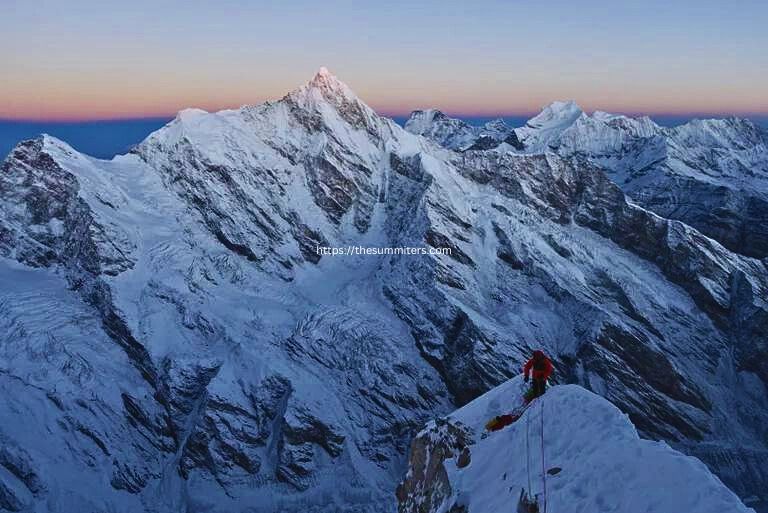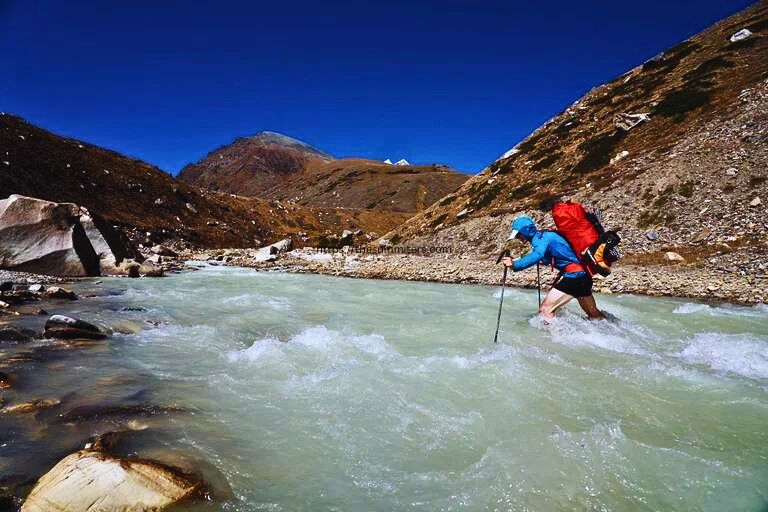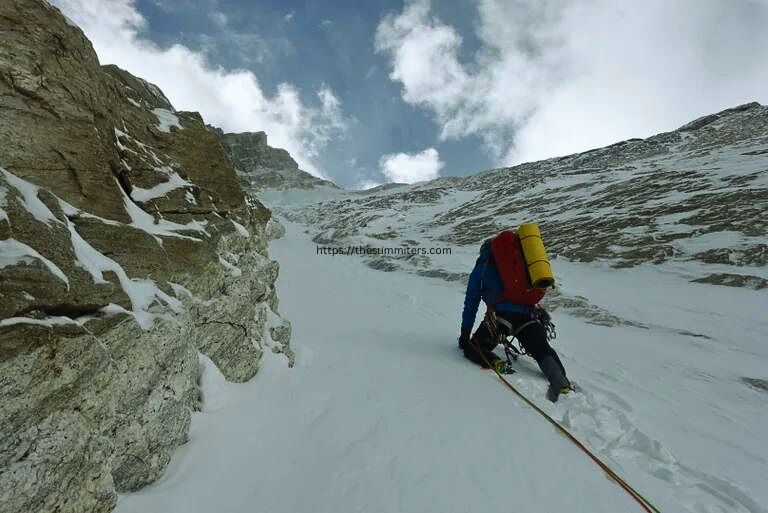Paul Ramsden and Tim Miller Go 8 Days on Unclimbed 6000-meter Peak
Two British climbers, Tim Miller and Paul Ramsden, conquered an unclimbed 6,605-meter peak in Nepal’s remote Surma-Sarovar region on October 25. Their eight day journey was filled with challenges including a grueling 2,100-meter climb up the North Face which is rated as “extremely difficult.” Despite the lack of advanced technicalities the expedition was demanding due to the high altitude, lengthy approach and harsh weather conditions.

Challenges Amid Heights: A Grueling Himalayan Expedition
Miller described the daunting challenge of navigating through the complex gorge at the mountain’s base and dealing with numerous tricky river crossings in the valley. For Ramsden, a seasoned climber and recipient of multiple Piolets d’Or awards, this trip was one of two he planned before starting a new job that would limit his mountaineering for a few years. The first adventure, which they accomplished in 2022, involved scaling the 6,563-meter Jugal Spire near Kathmandu, earning them another Piolets d’Or accolade. This time, their primary goal was to explore the isolated Salimor Khola Valley tucked away in Nepal’s remote northwest region, close to the borders of India and Tibet. To aid their exploration and attempt a first ascent, they enlisted the help of friends and fellow climbers Matt Glenn and Hamish Frost.
Journey to the Summit
Before setting out, Ramsden and Miller, who initially met in 2014 when Ramsden gave a lift to Miller hitchhiking after a climb, had scarce information and only a loose plan for their expedition. Ramsden had identified three peaks using Google Earth that he deemed worth investigating, but little was known about them. They attempted to gather as much information as possible, discovering that few climbers had ventured into the valley since the ‘80s. The summit they eventually conquered had been attempted merely twice before, in 2021 and 2022, by climbers Benjamin Lieber and John Kelly—information they learned only after returning home. It remained uncertain whether Lieber and Kelly had reached the base of Surma-Sarovar peak.
Summit Reflections
Miller remembered how challenging it was to get into the upper part of the valley because of a tough gorge mentioned in many trip reports. Their main plan was just to explore this seldom-visited valley and attempt a climb there.
After a flight from Kathmandu to Dhangadi, enduring almost two days in a bumpy jeep along twisty roads, facing a scare from an earthquake, and walking for six days through villages and up into the mountains, the group finally reached the infamous gorge, rumored to be their first big challenge.
“It’s a really steep gorge, and you have to move sideways across a cliff,” described Miller. Luckily, there was a shallow ledge system running across the mountain, but traversing it was pretty tough, almost like climbing steeply with a 200-meter drop below.
The climbers didn’t use ropes for this part, but it was too tricky for their helpers to handle. They had to make their base camp below the gorge, making it hard to acclimate or scope out potential climbs since they had to cover an extra difficult five kilometers every time.
After a comprehensive week of scouting the area, Miller and Ramsden eventually settled on the challenging North Face of Surma-Sarovar as their primary objective. Meanwhile, Frost and Glenn opted for a daunting peak with a compact rock face that posed challenges due to insufficient protective measures. Their attempt at a second 6,500-meter peak was thwarted merely 200 meters shy of the summit due to adverse weather conditions and unstable snow formations.
As for Miller and Ramsden’s target, Surma-Sarovar appeared to offer viable routes for both ascent and descent, except for a particularly questionable headwall.
“Surma-Sarovar is a multifaceted mountain, riddled with various ridges, hanging glaciers, icy formations called seracs, and prominent rock projections,” Miller described. Peering through binoculars we spotted a twisting weakness, it almost wound its way around the mountain like a corkscrew obstructing a clear view of the entire face at once. We also managed to catch a glimpse of a potential descent route.” Based on this brief reconnaissance, the duo made the decision to commit to this challenging climb.

British Climber’s Challenging Ascent
Reaching the mountain’s base was tough, taking two full days of walking and a river crossing that led them miles away from their intended path. But once they started climbing, things got a bit easier.
The climb kicked off with an 800-meter stretch of steep snow in a winding gully on the face. Occasionally, it narrowed into trickier sections involving mixed and ice climbing, about as challenging as WI 3 and M4 grades, where they used ropes. Ramsden, however, prefers not to rate each section, opting for overall ratings like TD or ED.

“I don’t really grade climbs,” Ramsden explained. “It’s too subjective up in the high altitudes and kind of doesn’t really mean much. Plus, it’s a small protest against the exaggerated ratings you see on social media from pro climbers nowadays.”
After the initial 800 meters, they managed to bivy just outside the gully, finding shelter under a steep rock face.
On their second day, Miller and Ramsden climbed together on easier terrain, leading to a steep 60-degree section of icy ground that made their calf muscles burn. Above this lay a daunting rock headwall, the biggest unknown of their climb. They camped under this headwall after another tiring 800-meter day.
We reached this rocky part that seemed steeper than what we’d seen so far described Miller. When we looked up from below we thought it might involve really vertical climbing, maybe needing some aid. It looked pretty intimidating.
However, they swiftly discovered a hidden chimney system concealed behind a tower.
I initially thought it’d be a tough steep section with rough compact rock, Miller recalled. But when we arrived, the rock quality surprised us, it was actually better than expected and not as challenging. I distinctly remember enjoying those climbing stretches.
Following some moderate mixed climbing on the headwall starting around M3 difficulty, progressing gradually to M5, they reached the summit of the tower. It turned out to be an incredible spot, serving as their impressive bivouac site before their final push for the summit.
On the fourth day of their ascent, they embarked towards the summit, arriving around noon. While the final leg lacked intricate technical climbing, the plummeting temperatures, heavy snowfall, and reduced visibility hindered their pace compared to the previous days.
We’d climb for a few minutes and then had to shake our hands to get the blood circulating, Miller recounted. I had to keep making ledges to move my feet because they were getting really cold. So each section took quite some time.
The weather deteriorated further, obscuring any view from the summit and complicating their search for the descent route. They opted to spend the night slightly below the summit, waiting for the weather to clear. Unfortunately, an intense snowstorm overnight drastically escalated the risk of avalanches for their descent.
Descent Challenges
According to Miller, the descent turned out to be the most challenging part of the entire climb, lasting a grueling two full days. It involved navigating through deep snow, executing complex diagonal rappels, maneuvering around icy chunks, and cautiously descending on unstable, snow-covered, and rocky slopes. At one point, Miller vividly remembered the unsettling sensation and sound of snow collapsing beneath them, serving as a stark reminder to stay vigilant. Fortunately, the slope held firm, allowing them to continue their journey back to base camp, which they reached eight days after their initial departure.
Paul and I were completely drained, barely able to form coherent sentences, Miller recounted. It was a lengthy process and mentally taxing due to the constant threat of avalanches. We kept slipping on the tricky terrain, but eventually, we descended to the glacier and made our way out. However, we were incredibly thirsty.
For Miller, the actual summit moment tends to be less of a highlight. For him, the true reward lies in the moments spent immersed in the mountain environment.
It’s those little, fleeting moments that really stick with you like peeking out of the tent in the morning and witnessing a breathtaking sunrise. Taking a pause to absorb the surroundings and appreciate the sheer beauty, he expressed. At times it feels as if you’re in a completely different world. The mountains seem to radiate this vibrant orange hue, standing at 6,000 meters, it’s an experience that feels entirely surreal and distant from everyday life.
Read More: Colin Haley’s Solo Winter Ascent of Cerro Torre